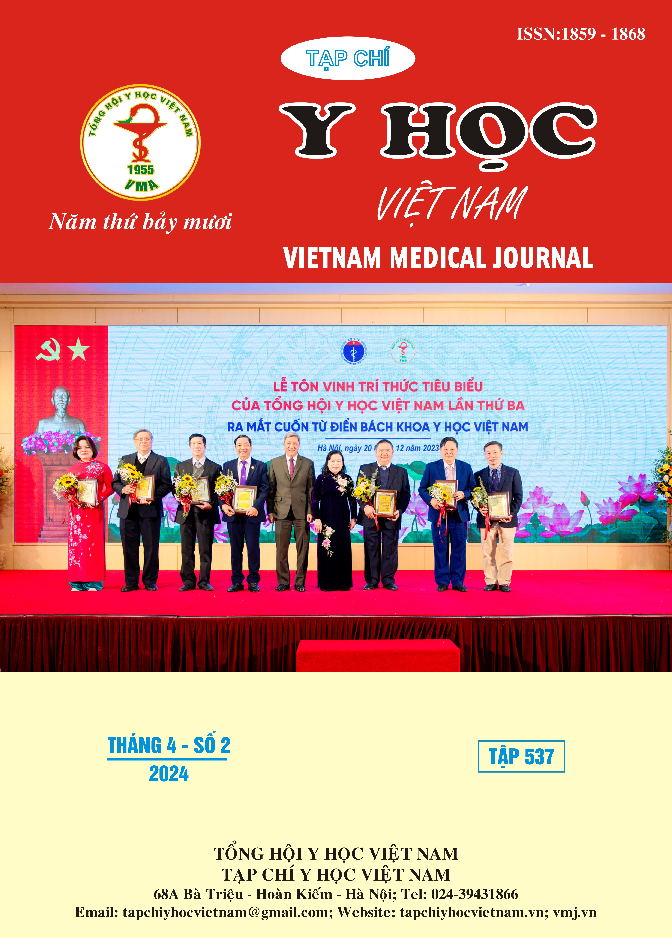TO EVALUATE THE OUTCOMES OF REFRACTIVE CORRECTION WITH CLEAR SURGERY
Main Article Content
Abstract
Purpose: To evaluate the outcomes of refractive correction with CLEAR surgery and investigate related factors. Method: This prospective descriptive study involved a total of 85 eyes of 43 patients with refractive errors and treated with CLEAR surgery. The study took place at Hong Son Eye Hospital between August 2022 to August 2023. The inclusion criteria required participants to be over 18 years old, have stable refraction for at least 12 months, and have myopia between - 0.5 to -10.0 D, and astigmatism between 0 to - 5.0 D. Convenient sampling methods were used to select participants until the sample size was sufficient. The data was analyzed using SPSS 20 software. Results: After surgery, UDVA increased at 1 week and 1 month, and stabilized at 3 and 6 months to 0.019 and 0.016 (LogMAR), respectively. The proportion of patients achieving 20/20 UDVA increased after surgery and at each follow-up. After 6 months, 97.6 % achieved 20/20 or better and 100 % achieved 20/30 or better. After surgery, Spherical Equivalent Refactive Accuracy gradually reduces and stabilizes within six months, resulting in an average value of -0.24 ± 0.27 D. About 70.6 % of patients exhibit a post-surgery spherical equivalent refraction (SEQ) value of around ± 0.25D, while only 2.4 % have a value higher than 1.0 D. Furthermore, after surgery, the lower the SEQ, the higher the UDVA. Six months after correction, the proportion of residual astigmatism (Refractive Astigmatism) ≤ 0.25 D is 94.1 % and ≥ 1.0 D is 100 %. The central corneal thickness (CCT) decreased by 17.36 μm for every diopter corrected, resulting in an average thickness of 441.1 ± 40.7 μm after six months of surgery.The corneal refractive power (CRP) after six months of surgery was 38.9 ± 1.9 D on average. The safety index of CLEAR surgery was 1.06 and the efficacy index was 1.03. Several factors related to surgical outcomes were analyzed in the study: The UDVA showed stability and comparability between three groups with mild, moderate, and severe pre-operative myopia at 3 and 6 months after surgery. The SEQ after surgery remained comparable for all levels of myopia. Additionally, the higher the refractive error, the thinner the CCT and the lower the CRP after surgery. Conclusions: Six months after undergoing refractive correction with CLEAR surgery, the average UDVA is 0.016 LogMAR, As many as 97.6 % of the patients achieved 20/20 visual acuity. The SEQ was found to be -0.24 ± 0.27 D, with 88.2% of patients having SEQ around 0.5 D. The UDVA stabilizes within three or six months. The SEQ after surgery remained consistent for all levels of myopia. Furthermore, it was observed that the higher the refractive error, the thinner the CCT and the lower CRP after the surgery.
Article Details
Keywords
Visual acuity, spherical equivalent (SE), CLEAR surgery
References
2. Leccisotti A, Fields SV, De Bartolo G. Refractive Corneal Lenticule Extraction With the CLEAR Femtosecond Laser Application. Cornea. Oct 1 2023;42(10):1247-1256.
3. Doga AV, Kostenev SV, Mushkova IA, Nosirov PO. Results of corneal lenticule extraction for correction. Vestnik oftalmologii. 2020;136 (6. Vyp. 2): 214-218. Rezul'taty ekstraktsii lentikuly rogovitsy dlya korrektsii miopii srednei i vysokoi stepeni.
4. Shady T. Awwad YB. Visual Outcomes With CLEAR Lenticule Extraction. crstodayeuropecom. 2022;
5. Nguyễn Thị Hương Loan. Đánh giá kết quả của phẫu thuật Smile tại Bệnh viện Mắt Quốc tế DND. Luận văn thạc sĩ. Đại học Y Hà Nội; 2019.


